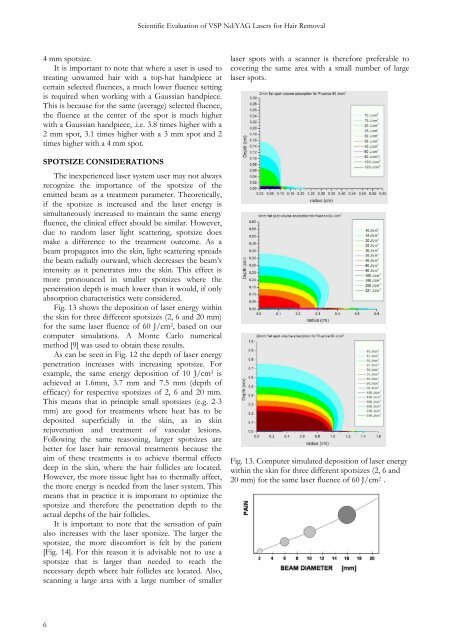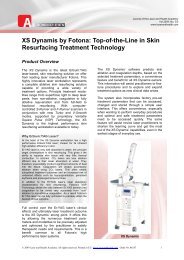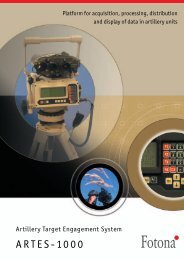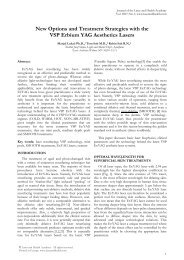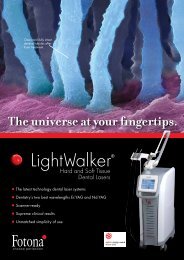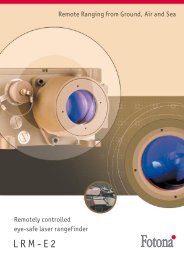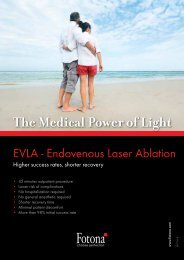Scientific Evaluation of VSP Nd:YAG Lasers for Hair Removal - Fotona
Scientific Evaluation of VSP Nd:YAG Lasers for Hair Removal - Fotona
Scientific Evaluation of VSP Nd:YAG Lasers for Hair Removal - Fotona
Create successful ePaper yourself
Turn your PDF publications into a flip-book with our unique Google optimized e-Paper software.
<strong>Scientific</strong> <strong>Evaluation</strong> <strong>of</strong> <strong>VSP</strong> <strong>Nd</strong>:<strong>YAG</strong> <strong>Lasers</strong> <strong>for</strong> <strong>Hair</strong> <strong>Removal</strong><br />
4 mm spotsize.<br />
It is important to note that where a user is used to<br />
treating unwanted hair with a top-hat handpiece at<br />
certain selected fluences, a much lower fluence setting<br />
is required when working with a Gaussian handpiece.<br />
This is because <strong>for</strong> the same (average) selected fluence,<br />
the fluence at the center <strong>of</strong> the spot is much higher<br />
with a Gaussian handpiece, .i.e. 3.8 times higher with a<br />
2 mm spot, 3.1 times higher with a 3 mm spot and 2<br />
times higher with a 4 mm spot.<br />
SPOTSIZE CONSIDERATIONS<br />
The inexperienced laser system user may not always<br />
recognize the importance <strong>of</strong> the spotsize <strong>of</strong> the<br />
emitted beam as a treatment parameter. Theoretically,<br />
if the spotsize is increased and the laser energy is<br />
simultaneously increased to maintain the same energy<br />
fluence, the clinical effect should be similar. However,<br />
due to random laser light scattering, spotsize does<br />
make a difference to the treatment outcome. As a<br />
beam propagates into the skin, light scattering spreads<br />
the beam radially outward, which decreases the beam’s<br />
intensity as it penetrates into the skin. This effect is<br />
more pronounced in smaller spotsizes where the<br />
penetration depth is much lower than it would, if only<br />
absorption characteristics were considered.<br />
Fig. 13 shows the deposition <strong>of</strong> laser energy within<br />
the skin <strong>for</strong> three different spotsizes (2, 6 and 20 mm)<br />
<strong>for</strong> the same laser fluence <strong>of</strong> 60 J/cm 2 , based on our<br />
computer simulations. A Monte Carlo numerical<br />
method [9] was used to obtain these results.<br />
As can be seen in Fig. 12 the depth <strong>of</strong> laser energy<br />
penetration increases with increasing spotsize. For<br />
example, the same energy deposition <strong>of</strong> 10 J/cm 3 is<br />
achieved at 1.6mm, 3.7 mm and 7.5 mm (depth <strong>of</strong><br />
efficacy) <strong>for</strong> respective spotsizes <strong>of</strong> 2, 6 and 20 mm.<br />
This means that in principle small spotsizes (e.g. 2-3<br />
mm) are good <strong>for</strong> treatments where heat has to be<br />
deposited superficially in the skin, as in skin<br />
rejuvenation and treatment <strong>of</strong> vascular lesions.<br />
Following the same reasoning, larger spotsizes are<br />
better <strong>for</strong> laser hair removal treatments because the<br />
aim <strong>of</strong> these treatments is to achieve thermal effects<br />
deep in the skin, where the hair follicles are located.<br />
However, the more tissue light has to thermally affect,<br />
the more energy is needed from the laser system. This<br />
means that in practice it is important to optimize the<br />
spotsize and there<strong>for</strong>e the penetration depth to the<br />
actual depths <strong>of</strong> the hair follicles.<br />
It is important to note that the sensation <strong>of</strong> pain<br />
also increases with the laser spotsize. The larger the<br />
spotsize, the more discom<strong>for</strong>t is felt by the patient<br />
[Fig. 14]. For this reason it is advisable not to use a<br />
spotsize that is larger than needed to reach the<br />
necessary depth where hair follicles are located. Also,<br />
scanning a large area with a large number <strong>of</strong> smaller<br />
laser spots with a scanner is there<strong>for</strong>e preferable to<br />
covering the same area with a small number <strong>of</strong> large<br />
laser spots.<br />
Fig. 13. Computer simulated deposition <strong>of</strong> laser energy<br />
within the skin <strong>for</strong> three different spotsizes (2, 6 and<br />
20 mm) <strong>for</strong> the same laser fluence <strong>of</strong> 60 J/cm 2 .<br />
6


